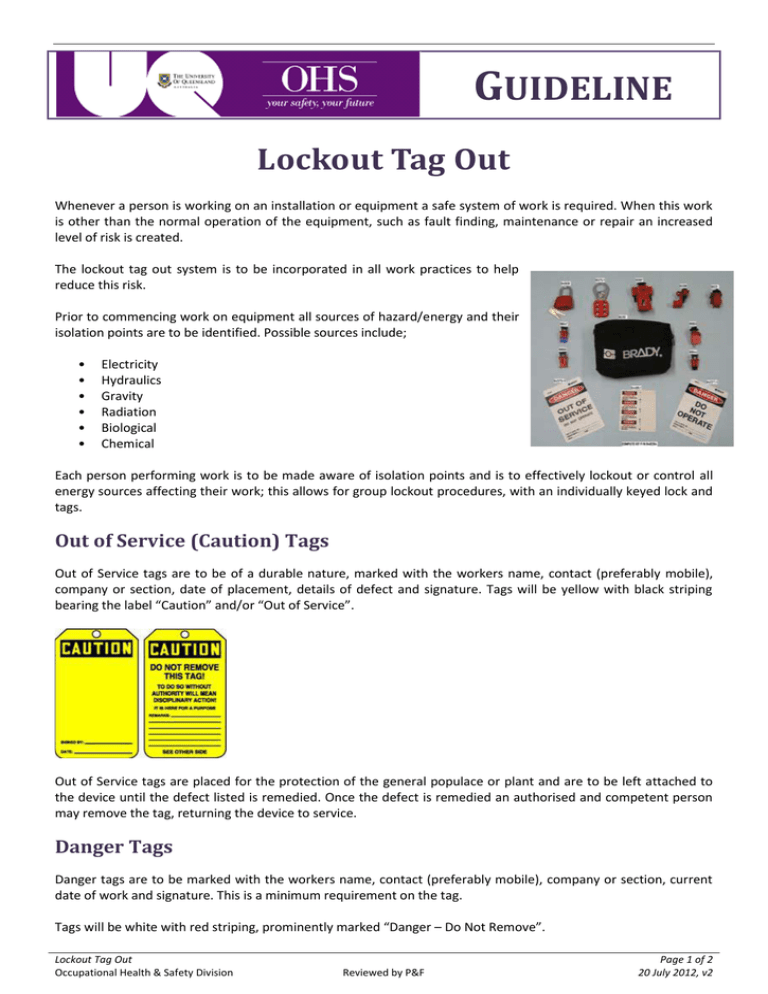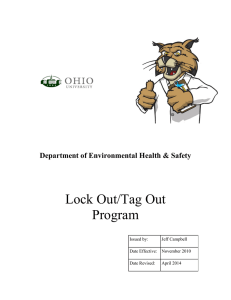GUIDELINE Lockout Tag Out
advertisement

GUIDELINE Lockout Tag Out Whenever a person is working on an installation or equipment a safe system of work is required. When this work is other than the normal operation of the equipment, such as fault finding, maintenance or repair an increased level of risk is created. The lockout tag out system is to be incorporated in all work practices to help reduce this risk. Prior to commencing work on equipment all sources of hazard/energy and their isolation points are to be identified. Possible sources include; • • • • • • Electricity Hydraulics Gravity Radiation Biological Chemical Each person performing work is to be made aware of isolation points and is to effectively lockout or control all energy sources affecting their work; this allows for group lockout procedures, with an individually keyed lock and tags. Out of Service (Caution) Tags Out of Service tags are to be of a durable nature, marked with the workers name, contact (preferably mobile), company or section, date of placement, details of defect and signature. Tags will be yellow with black striping bearing the label “Caution” and/or “Out of Service”. Out of Service tags are placed for the protection of the general populace or plant and are to be left attached to the device until the defect listed is remedied. Once the defect is remedied an authorised and competent person may remove the tag, returning the device to service. Danger Tags Danger tags are to be marked with the workers name, contact (preferably mobile), company or section, current date of work and signature. This is a minimum requirement on the tag. Tags will be white with red striping, prominently marked “Danger – Do Not Remove”. Lockout Tag Out Occupational Health & Safety Division Reviewed by P&F Page 1 of 2 20 July 2012, v2 Danger tags are to be placed only for the protection of personnel working on plant, they are not to be left on after that person completes their work, or finishes their shift. Changeover procedures may be required in certain situations, or an Out of Service Tag is to be placed if an item is unfit for use after the worker has left. Danger tags are to be used in conjunction with locks. Danger tags are to only be removed by the person who placed them. In the event they cannot be made available an approved procedure for determining their location, the status of the equipment, risk assessment and then removal of the tag is to be followed. Personal Locks Each person who is likely to be in a position to lockout a piece of equipment for work must be issued with a minimum of one individually keyed lock. This lock is to be used in conjunction with a Danger tag. Locks are to only be removed by the person who placed them. In the event they can not be made available an approved procedure for determining their location, the status of the equipment, risk assessment and then removal of the lock is to be followed. Lockout Devices A wide range of devices is available to lockout various plant and equipment, whichever device is chosen must effectively prevent the isolation point from being operated. Group Lockouts Where multiple points of isolation are required, or multiple workgroups are in an area, approved group lockout procedures may be employed to enhance control of isolation. Each worker must still be able to effect control over sources of energy likely to affect them. Contact for Additional Information Mr Greg Brown Email: g.brown@pf.uq.edu.au Phone: 07 3346 9268 (internal 69268) Lockout Tag Out Occupational Health & Safety Division Reviewed by P&F Page 2 of 2 20 July 2012, v2





